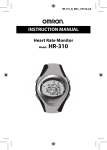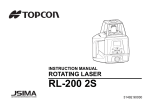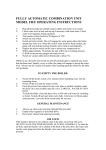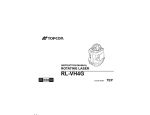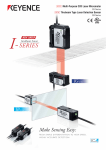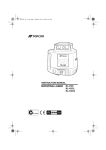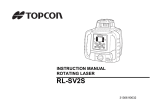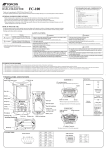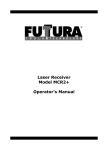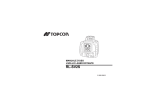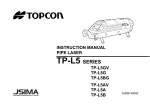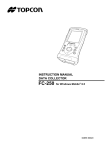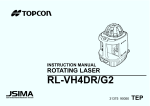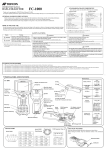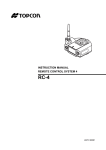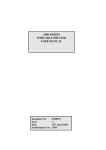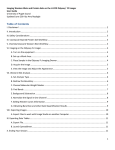Download RL-200 1S Manual - Survey Equipment
Transcript
ENT ESC MENU Y INSTRUCTION MANUAL ROTATING LASER RL-200 1S 31491 90030 Foreword Thank you for purchasing the Topcon RL-200 1S Rotating Laser. It is one the world’s most advanced and accurate grade-setting lasers. To quickly and effectively use the RL-200 1S, please read these brief instructions carefully, and keep them in a convenient location for future reference. Precautions Guarding the instrument against shock When transporting the instrument, provide some protection to minimize risk of shock. Heavy shocks may affect beam accuracy. Sudden changes of temperature A sudden change in temperature may cause water condensation on the glass used for the laser emission part. In such a case, let the instrument stand for a while to allow it to adjust to the temperature prior to actual use. Caution: Use of adjustment controls or performance procedures other than those specified herein may results in hazardous radiation exposure. 1 Precautions for Safe Operation For the safe use of the product and prevention of injury to operators and other persons as well as prevention of property damage, items which should be observed are indicated by an exclamation point within a triangle used with WARNING and CAUTION statements in this instruction manual. The definitions of the indications are listed below. Be sure you understand them before reading the manual’s main text. Definition of Indication WARNING Ignoring this indication and making an operation error could possibly result in death or serious injury to the operator. CAUTION Ignoring this indication and making an operation error could possibly result in personal injury or property damage. This symbol indicates items for which caution (hazard warnings inclusive) is urged. Specific details are printed in or near the symbol. This symbol indicates items which are prohibited. Specific details are printed in or near the symbol. This symbol indicates items which must always be performed. Specific details are printed in or near the symbol. 2 General Warning Do not perform disassembly or rebuilding. Fire, electric shock or burns could result. Do not use the unit in areas exposed to high amounts of dust or ash, in areas where there is inadequate ventilation, or near combustible materials. An explosion could occur. When securing the instrument in the carrying case make sure that all catches, including the side catches, are closed. Failure to do so could result in the instrument falling out while being carried, causing injury. Caution Do not use the carrying case as a footstool. The case is slippery and unstable so a person could slip and fall off it. Do not place the instrument in a case with a damaged case or belt. The case or instrument could be dropped and cause injury. 3 Power Supply Warning Do not short circuit. Heat or ignition could result. Do not use voltage other than the specified power supply voltage. Fire or electrical shock could result. Do not use damaged power cords, plugs or loose outlets. Fire or electric shock could result. Do not use power cords other than those designated. Fire could result. Do not use batteries other than those designated. An explosion could occur, or abnormal heat generated, leading to fire. Do not place articles such as clothing on the battery charger while charging batteries. Sparks could be induced, leading to fire. Use only the specified battery charger to recharge batteries. Other chargers may be of different voltage rating or polarity, causing sparking which could lead to fire or burns. Do not heat or throw batteries into fire. An explosion could occur, resulting in injury. 4 Do not use the battery or charger for any other equipment or purpose. Fire or burns caused by ignition could result. To prevent shorting of the battery in storage, apply insulating tape or equivalent to the terminals. Otherwise shorting could occur, resulting in fire or burns. Do not use batteries or the battery charger if wet. Resultant shorting could lead to fire or burns. Do not connect or disconnect power supply plugs with wet hands. Electric shock could result. Caution Do not touch liquid leaking from batteries. Harmful chemicals could cause burns or blisters. 5 Tripod Caution When mounting the instrument to the tripod, tighten the centering screw securely. Failure to tighten the screw properly could result in the instrument falling off the tripod, causing injury. Tighten securely the leg fixing screws of the tripod on which the instrument is mounted. Failure to tighten the screws could result in the tripod collapsing, causing injury. Do not carry the tripod with the tripod shoes pointed at other persons. A person could be injured if struck by the tripod shoes. Keep hands and feet away from the tripod shoes when fixing the tripod in the ground. A hand or foot stab wound could result. Tighten the leg fixing screws securely before carrying the tripod. Failure to tighten the screws could lead to the tripod legs extending, causing injury. 6 User Wear the required protectors (safety shoes, helmet, etc.) when operating. Exceptions from Responsibility • The user of this product is expected to follow all operating instructions and make periodic checks of the product’s performance. • The manufacturer, or its representatives, assumes no responsibility for results of a faulty or intentional usage or misuse including any direct, indirect, consequential damage, and loss of profits. • The manufacturer, or its representatives, assumes no responsibility for consequential damage, and loss of profits by any disaster, (an earthquake, storms, floods etc.). A fire, accident, or an act of a third party and/or a usage any other usual conditions. • The manufacturer, or its representatives, assumes no responsibility for any damage, and loss of profits due to a change of data, loss of data, an interruption of business etc., caused by using the product or an unusable product. • The manufacturer, or its representatives, assumes no responsibility for any damage, and loss of profits caused by usage except for explained in the user manual. • The manufacturer, or its representatives, assumes no responsibility for damage caused by wrong movement, or action due to connecting with other products. 7 Laser Safety Information The RL-200 1S is classified as a class 3R Laser Product according to IEC Standard Publication 60825-1 Ed.2.0: 2007 and United States Government Code of Federal Regulation FDA CDRH 21CFR Part1040.10 and 1040.11 (Complies with FDA performance standards for laser products except for deviations pursuant to Laser Notice No.50, dated June 24, 2007.) Laser Safety This product projects a visible laser beam during operation. This product is manufactured and sold in accordance with “Performance Standards for Light-Emitting Products” (FDA/BRH 21 CFR 1040) or “Radiation Safety of Laser Products, Equipment Classification, Requirements and User’s Guide” (IEC Publication 60825-1) provided on the safety standards for laser beam. As per the said standard, RL-200 1S standard model is classified as “Class 3R (IIIa) Laser Products”. These are simple products to operate and do not require training from a laser safety officer. In case of any failure, do not disassemble the instrument. Contact TOPCON or your TOPCON dealer. 8 Visible laser Laser output: 2.5mW Beam aperture LASER RADIATION AVOID DIRECT EYE EXPOSURE WAVE LENGTH 685nm 5mW MAXIMUM OUTPUT CLASS a LASER PRODUCT Explanatory Label Each label is differed by the market. Warning • Use of controls or adjustments or performance of procedures other than those specified herein may result in hazardous radiation exposure. 9 • Never intentionally point the laser beam at another person. The laser beam is injurious to the eyes and skin. • Do not look directly into the laser beam. Doing so could cause permanent eye damage. • Do not stare at the laser beam. Doing so could cause permanent eye damage. • Never look at the laser beam through a telescope, binoculars or other optical instruments. Doing so could cause permanent eye damage. • Sight targets so that the laser beam does not stray from them. Caution • Perform checks at start of work and periodic checks and adjustments with the laser beam emitted under normal conditions. • When disposing of the instrument, destroy the battery connector so that the laser beam cannot be emitted. • Operate the instrument with due caution to avoid injuries that may be caused by the laser beam unintentionally striking a person in the eye. Avoid setting the instrument at heights at which the path of the laser beam may strike pedestrians or drivers at head height. 10 • Only those who have received training as per the following items shall use this product. • Read the manual for usage procedures for this product. • Hazardous protection procedures (read "Laser Safety Information") • Requisite protective gear (read "Laser Safety Information") • Accident reporting procedures (stipulate procedures beforehand for transporting the injured and contacting physicians in case there are laser-induced injuries). • When the instrument is not being used, turn off the power. 11 Standard System Components Rechargeable battery type 1) 2) 3) 4) 5) 6) 7) 8) 9) Instrument.................................................... 1pc. Level Sensor LS-80L ................................... 1pc. Level Sensor Holder Model-6 ...................... 1pc. Battery holder DB-75C ................................ 1pc. Ni-MH battery pack BT-67Q ........................ 1set AC/DC converter AD-11............................... 1pc. AA-size dry cell batteries*1) ......................... 2pcs. Carrying case .............................................. 1pc. Instruction manual ....................................... 1vol. Dry battery type 1) 2) 3) 4) 5) 6) 7) 8) Instrument .................................................... 1pc. Level Sensor LS-80L ................................... 1pc. Level Sensor Holder Model-6 ...................... 1pc. Battery holder DB-75 ................................... 1pc. D-size dry cell batteries*2) ............................ 4pcs. AA-size dry cell batteries*3) .......................... 2pcs. Carrying case............................................... 1pc. Instruction manual........................................ 1vol. • Please make sure that all of above items are in the box when you unpack. *1), *2), *3) Batteries included in the package are to confirm the initial operation. Please replace the batteries provided with new batteries (alkaline) as soon as possible. 12 Contents Foreword .......................................................................................................................................1 Precautions ..............................................................................................................................1 Precautions for Safe Operation................................................................................................2 User..........................................................................................................................................7 Exceptions from Responsibility ................................................................................................7 Laser Safety Information ..........................................................................................................8 Standard System Components ..............................................................................................12 Contents......................................................................................................................................13 Nomenclature..............................................................................................................................15 Sample Display ......................................................................................................................17 Key Functions ........................................................................................................................18 RL-200 1S LED Display .........................................................................................................18 Basic Operation...........................................................................................................................19 Preparation and Functions ..........................................................................................................20 Power Source.........................................................................................................................20 Setting Up Instrument ............................................................................................................20 Power Switch .........................................................................................................................20 Battery Status Display............................................................................................................21 Setting Grade .........................................................................................................................22 Aligning Direction of Grade ....................................................................................................23 How to Enter Grade ...............................................................................................................24 Menu ...........................................................................................................................................25 How to Set the Menu..............................................................................................................25 13 Maintaining Power Sources ........................................................................................................32 How to Change Batteries on the Instrument ..........................................................................32 Check and Adjusting ...................................................................................................................36 Horizontal Calibration.............................................................................................................36 Horizontal Rotation Cone Error ..............................................................................................40 Grade Setting Error ................................................................................................................41 Storage Precautions....................................................................................................................43 Standard Accessories .................................................................................................................44 Specifications ..............................................................................................................................49 Error Display ...............................................................................................................................51 Regulations .................................................................................................................................53 14 Nomenclature Rotary head/Laser emitting window Beam aperture Display Handle ENT ESC MENU Y Control panel Battery holder Battery compartment lock 15 Control panel MENU key Enter key Escape key Y key ESC ENT Auto-leveling indicator MENU Y Power switch Arrow keys 16 Sample Display Normal display Y axis grade (Blinks digit by digit during leveling) Auto-leveling indicator (Blinks during leveling) Rotation speed (rpm) Battery remaining Menu screen display See “Menu” on page 25. 17 Key Functions Enter key End Operation of Data Input and Sends data to the instrument. Escape key Cancels input or escape to previous status. Y key Sets Y axis grade. Menu and arrow keys Selects menu items. Inputs the grade of Y axis. Sets the masking direction. Power switch On/Off of the RL-200 1S. RL-200 1S LED Display There is an LED that signals auto-leveling of the control panel screen of the main instrument. Flashing : Auto-leveling or grade setting is in process. The rotary head is not rotating. ON solid : Auto-leveling grade setting is complete. The rotary head is active and emits the laser beam. You can stop the auto-leveling function. Refer to “3) Sensitivity Level” on page 29 to stop the function. 18 Basic Operation Normal precision mode High precision mode 1 Set the instrument on a tripod or smooth surface and turn on the power. 2 3 Set Y axis grade. 4 Check the rotating beam elevation using the level sensor. Turn on the level sensor. Check the operation surface by using the level sensor. If high-precision detection is desired, select that setting on the level sensor. Higher than datum position (Buzzer sound: High frequent beep sound) Move the sensor downward. Datum position (Buzzer sound: Continuous beep sound) Lower than datum position (Buzzer sound: Low frequent beep sound) Level sensor Move the sensor upward. (For more information about level sensor refer to “Level Sensor LS-80L” on page 45 section.) 19 Preparation and Functions Power Source Connect the battery according to the battery type purchased. For charging and battery replacement instructions, see the “Maintaining Power Sources” on page 32 section. Setting Up Instrument Set the instrument on a tripod or smooth surface. The instrument must be within horizontal ±5 degrees of true level for auto-leveling to operate. ENT ESC MENU Y Power Switch ±5° When the power switch on the instrument is turned on, auto-leveling and automatic grade setting will activate. 20 Battery Status Display Remaining battery level is displayed at the lower bar in the display area. : Battery is sufficient. : Battery is sufficient. : Battery is sufficient. Battery remaining display : The power is low, but laser is still usable. (Indication continues until batteries are dead.) RL BATTERY LOW : Dead batteries of RL-200 1S. Recharge the battery or replace the dry batteries with new ones. If an AC/DC converter is connected to the main instrument when the main instrument is displaying “RL BATTERY LOW”, the remaining battery level display will not change. Once the power is turned off, the battery remaining display will reset. For handling batteries, see the “Maintaining Power Sources” on page 32. 21 Setting Grade Grade can be set in Y axis, as shown below. Grade can be set in the range indicated below. Y: –5% to +25% Grade axes and axis symbols are as shown in the diagram below. +25% Y axis Plus Minus ESC ENT MENU 22 –5% Aligning Direction of Grade When using the laser with a percent of grade entered, the laser must be properly aligned so the slope of the laser beam is parallel to the desired direction of grade. The sighting collimator on top of the instrument is calibrated to the grade axis of the laser beam. Follow the steps below to align the laser to the desired direction of grade: 1 2 Establish a target line parallel to desired direction of grade. 3 Rough align the instrument to the direction of grade. Make sure it is properly oriented for the grade to be entered, positive or negative. (See page 22) 4 5 Place a rod or other target down range on the target line. ESC ENT MENU Y Set up the laser over this line (drop a plumb bob from the tripod mounting screw). While sighting through the collimator, adjust the instrument until the sight is aligned with the target. (See the figures on the right.) Target Plus direction Minus direction 23 Single axis Grade range: Y: –5% to +25% How to Enter Grade 1 2 3 4 5 Press the Y key to begin grade input. The axis symbol will flash and it will go into grade entry status. Select positive or negative grade by pressing arrow keys (Up or Down). Y axis Move the cursor by pressing the arrow keys (Right or Left). Increase or decrease the number by pressing the arrow keys (Up or Down). Press the [ENT] key to finish input. When holding down the [Y] key while the Y symbol is flashing, the flashing axis will reset to 00.000%. 24 Menu How to Set the Menu As indicated by arrows in the figure, there are 5 setting categories in the menu and selection and changes of the settings are performed using the arrow keys and [ENT] key. 1 2 3 4 5 Press the [MENU] key to display the menu screen. As you can see, the mask setting is framed with the cursor. Move the cursor to the item you would like to set up using the arrow keys and press the [ENT] key. The selected item will start flashing. 1) Changing Masking ModeC(P. 26 ) 2) Changing rotary head speed C(P. 28 ) Select the setting details using the arrow keys. Press the [ENT] key to lock the setting. In the same manner, select and change the next setting. 5) Alarm Signal C(P. 31 ) 4) Safety Lock System C(P. 30 ) 3) Sensitivity LevelC(P. 29 ) 25 1) Changing Masking Mode Sets up masking (laser beam shutter) and change shut off directions. Masking (Laser beam shutter) setting Depending on the status of the location where the instruments are used, laser beam emission to unnecessary direction can be shut off. 1 Press the [MENU] key to display the menu screen. The mask setting will be displayed on the right in the upper side of the screen. 2 Use the arrow keys to position on the Mask display and press the [ENT] key. The state when masking is not activated (Laser beams are emitted to all directions.) 3 4 26 Select the direction you desire to mask using the arrow keys. Each press repeats mask activating/ releasing. When desired masking is displayed, press the [ENT] key to finish. Confirm the [OK] mark on the display. Displays the masking direction Displays the direction that laser beam is emitted. The status in which the X+ direction is masked. (Laser beam is shut off in the X+ direction.) Switching Masking Mode (Split-masking Direction) Mode 1 As seen from above Mode 2 As seen from above X axis Y axis You can select either Mode 1 or Mode 2 for the masking mode. The relationship between the arrow keys and masking directions are shown in the above figure. 27 Masking Mode Setting 1 2 3 Follow steps 1-2 for the masking setting. Each press of [Y] key toggles Mask Mode 1 and Mask Mode 2. Press the [ENT] key to lock the entry. Sample display Mode 1 Mode 2 2) How to change the rotary head speed (300, 600, 900 R.P.M.) The rotary head speed can be set to 300, 600 or 900 R.P.M. Press the [MENU] key to display the menu screen. Use the arrow keys to select the changing rotary head speed and press the [ENT] key. When the head speed starts flashing, select the desired speed using the arrow keys and press the [ENT] key. Changing rotary head speed Rotation speed 28 3) Sensitivity Level The sensitivity level allows the user to select the vibration level that is permitted during autoleveling or grade setting. Set a sensitivity level to suit the location where the instrument is used such as places that undergo many vibrations, and also in consideration of the operational precision. Two sensitivity levels can be set: large and small vibrations. Manual setting will stop the auto-leveling function. Large vibration Small vibration Manual Do not use the manual setting for sensitivity level except in special circumstances. If the manual setting is selected, the auto-leveling function will not operate, so the grading setting precision will not be assured at all. The manual setting will also deactivate the setting for Y-grade. 29 4) Safety Lock System When the instrument system detects a shock, this function informs the operate of it. (A safety lock is also called a height alert.) In case the safety lock system setting is ON, Safety Lock System will active. (This will be active around 10 minutes after turning on the power.) Should the installed status of the instrument suddenly change when auto-leveling is functioning and laser beam is being emitted, through, for example, unnecessary contact by the user, the auto-leveling function will automatically stop to protect operational precision. In such a case, the rotary head will act as below: When [5) Warning transmission] is activated: it will rotate slowly When [5) Warning transmission] in not activated: the rotation will stop Active Inactive Error : Blinks alternately How to reactivate Turning off the power for the instrument, and then turning it back on will activate the auto-leveling function. 30 5) Alarm Signal When used with the Topcon level sensor, the RL-200 1S can communicate alarm signals directly to the sensor. This helps enable the user to be completely aware of potential problems before they can become serious. Active Inactive 31 Maintaining Power Sources How to Change Batteries on the Instrument Rechargeable battery (BT-67Q) Installing 1 Insert Ni-MH BT-67Q battery pack into the DB-75C battery holder. 2 Insert the battery pack into the instrument and turn the battery cover knob to “LOCK”. Charging 1 Plug the AC/DC converter AD-11 into the DB-75C battery holder. 2 Plug the converter power cord into the appropriate AC outlet. 3 When charging is complete (after approximately seven hours), unplug the converter from the AC/DC converter connector on the DB-75C battery holder. AD-11 4 Unplug the converter power cord from the AC receptacle. ENT ESC MENU DB-75C 32 LED The LED of DB-75C will indicate charging status: Red ON : Charging. Green ON : Charging completed. Green flashing : Ni-MH BT-67Q battery pack is not installed correctly. Red flashing : Ni-MH BT-67Q battery pack protection feature is working automatically. RL-200 1S can be used in this state. The instrument has a protection feature which works when nickel hydride batteries are overcharged or when the batteries are under a high or low temperature (+70°C or higher, or 0°C or lower) state. In such a case, charging will stop automatically to protect nickel hydride batteries. Recharging should be performed in a room temperature ranging from +10°C to +40°C. Always use the AC/DC converter provided with the product. 1) The Ni-MH BT-67Q rechargeable battery can be charged while using the laser. 2) The Ni-MH BT-67Q rechargeable battery can be charged when the battery holder is removed from the instrument. This allows the option of alternately using two battery packs to always maintain a fully charged pack. 3) The Ni-MH BT-67Q rechargeable battery can be removed from the DB-75C battery holder and 4×D size dry cell batteries (alkaline) can be installed. 4) The DB-75 dry cell battery holder cannot be used to charge the BT-67Q Ni-MH battery pack. Use the DB-75C charging battery holder instead. BT-67Q DB-75C 33 1) For longer battery life, conform to the suggested charging time to the extent possible. 2) The battery source will discharge when stored and should be checked before using with instrument. 3) Be sure to charge stored battery source every 3 or 6 months and store in a place at 30 °C or below. If you allow the battery to become completely discharged, it will have an effect on future charging. 34 Dry battery How to replace dry batteries ENT ESC ; 1 Remove the battery cover by turning the battery cover knob to “OPEN”. 2 Remove the old batteries and replace with new batteries (4×D size dry cell batteries) matching [+] and [-] as shown in the figure. 3 Replace the battery cover and turn the knob to “LOCK”. MENU Replace all 4 batteries with new ones. Do not mix old batteries and new ones. 35 Check and Adjusting Horizontal Calibration (1) Checking Calibration X+ Y- Y+ XESC Y 1 Steadily set up a tripod approximately 50m from a staff member or wall and adjust so that the head of the tripod is horizontal. Mount the instrument on the tripod in the direction shown in the right figure (Y-axis facing the wall). 2 While pressing the [Y] key, turn on the power switch. 3 The flashing axis is the selected one. Select the axis to check using the arrow keys (right and left) and press the [ENT] key to lock. MENU ENT 50m (164feet) Level sensor Staff or Wall Turn on the power while pressing the [Y] key. X Y W X Select the axis using the arrow keys (right and left) and press the [ENT] key. 36 (Example: Y axis) 4 Select Y axis by pressing the right arrow key. Press the [ENT] key to lock. 5 “POSITION 1” display will flash and the instrument will begin auto-leveling. After the auto-leveling is completed, the “POSITION 1” light will turn on, then, the rotary head rotates and emits laser beam. (Y-). 6 Turn on the power for the level sensor, and press the detective precision switch to select the high detection mode. 7 Check the position of the laser beam (Y-) on the wall. Move the sensor up or down until the LCD indicator identifies the center of the laser beam. 8 After fixing the beam, press the [ENT] key. The display will change to flashing “POSITION 2”. POSITION 1 Check the laser beam on the wall. Fix the level sensor in the position where the LCD indicator identifies the center of the laser beam. Press the [ENT] key after check. POSITION 2 37 9 Loosen the tripod and rotate the instrument 180° and retighten to fix. The Y+ side of the instrument should be facing the wall. After the auto-leveling is completed, the display will change to [S][T], then, the rotary head rotates and emits laser beam. 10 Following step 7, mark the laser beam position for (Y+). If the two lasers being marked are misaligned for less than 3.5mm, adjustment is not necessary. Turn off the power for the instrument. If adjustment is required, move on to (2) How to adjust. Check the misalignment of laser beam of (Y+) and (Y-) on the wall. If one of the 3 center indicators is lit, calibration is normal. Misalignment of (Y-) and (Y+) laser beam within 3.5mm is considered normal. Turn off the power to complete the checking. When rotating the instrument 180º, ensure that the height of the instrument is aligned. (2) How to adjust After completing the checking in step 10, go on to the adjustment specified below. 1 Using the arrow keys (up and down), adjust the (Y+) laser beam to the center of (Y+) and (Y-). 2 Press the [ENT] key when the laser beam is correctly positioned in the center. S T By using the up and down arrow keys, adjust the (Y+) laser beam to the center of the (Y-) and (Y+). center ESC ENT MENU X/Y 38 Y+ rotating laser beam 3 “CALCULATING” will flash indicating that the calibration value is being calculated by the instrument. Do not touch the instrument until “END” is displayed to signify operation completed. (If you touch the instrument, you will need to recalibrate.) 4 When “END” is displayed, press the [ENT] key. The screen will return to the axis selection screen. If you wish to continue with checking the X axis, go back to step 3 for calibration check. 5 When you have completed the adjustment, turn off the power. After adjustment is completed, go through the checking procedure to check if the adjustment was done accurately. After positioning the laser beam, press the [ENT] key. CALCULATING END After calibration value is fixed, press the [ENT] key. X Y W X The screen goes back to the axis selection screen. If the correction value calculated exceeds the allowable range, the RL-200 1S will display error code [CALIBRATION OVER ERR]. Check the procedure again and perform any inspections and adjustments. If this error code is displayed again, repair is required. Contact your dealer or Topcon. 39 Horizontal Rotation Cone Error Perform the following check after completing “Horizontal Calibration” on the previous page. Minimum about 50 m/164 ft Cone error Wall A ESC ENT MENU X/Y Datum position Wall B Wall A ESC ENT MENU X/Y Wall B 1 Set up the laser centered between two walls approximately 50 m (164 ft) apart. Orient the instrument so one axis, either X or Y, is facing the walls. Grade should be set to 0.00% in both axes. 2 Locate and mark the position of the rotating laser beam on both walls using the level sensor. 3 Turn off the instrument and move the instrument closer to wall A (1 m to 2 m /3 ft to 6 ft). Do not change the axis orientation of the instrument. Turn the instrument on. 4 Again locate and mark the position of the rotating laser beam on both walls using the level sensor. 5 Measure the distance between the first and second marks on each wall. 6 If the difference between each set of marks is less than ±5 mm (±7/32 of an inch), no error exists. If the difference between [wall A]-side and [wall B]-side exceeds ±5 mm (±7/32 of an inch), contact your dealer or Topcon. 40 Grade Setting Error Perform the following check only after completing “Horizontal Calibration” and “Horizontal Rotation Cone Error”. (1) Checking 1 Setup the Y+ side facing the staff as shown in the figure. Level sensor ESC Staff ENT MENU X/Y Nail 1 Nail 2 Securely position Nail 1 and Nail 2 exactly 30m apart. 2 Turn on power for the instrument and verify the staff height of Nail 1 and Nail 2 at grade setting of 0% with level sensor and record. At this time the staff height for Nail 1 and Nail 2 should recorded as h1 and h2 (mm). Check the level sensor is set at high precision. 41 3 Set Y axis grade to -1.000%. Align read the elevation of the laser beam in millimeters at Nail 1 and Nail 2. Designate these elevations as “h3” at Nail 1, and “h4” at Nail 2. ESC ENT MENU X/Y Nail 1 Nail 2 4 Using the elevation readings for h1, h2, h3 and h4, complete the equation below. If the calculated result is the range of -0.990% to -1.010%, the instrument is normal. If the calculated result for either axis is out of the range, contact your dealer or Topcon. Repeat the procedure aligning the “X” axis on the line created by Nail 1 and Nail 2. 42 Storage Precautions (1) Always clean the instrument after use. 1) If the instrument got wet with rain, wipe it well before storing in the storage case. 2) Wipe away stain or dirt with soft cloth after dusting. (2) Clean storage case using cloth moistened with neutral detergent or water. Do not use ether, benzene, thinner or other solvents. (3) Store with the batteries removed, when operation is halted for more than a month. 43 Standard Accessories Level sensor holder model 6 154 153 152 151 150 149 Clamp knob 148 147 146 H O L D E R -6 131 9 138 137 136 135 134 133 132 131 Level sensor 44 Level sensor holder model 6 Level Sensor LS-80L Power switch The power switch turns ON or OFF by pressing. On-Grade precision switch Two on-grade precision options are available, normal precision (±2mm) and high precision (±1mm). By pressing this switch, the precision options are switched alternately. Confirm the precision choice by the indicator. (Normal precision is the default setting each time the sensor is turned on.) Buzzer sound switch Volume of the sensor buzzer can be alternately switched to LOW/LOUD/OFF by pressing the switch. Auto-cut off function Indicator LS-80L Display (P. 46) Detect the on-grade position "---" by moving the LS-80L up and down. Directional arrows and audio signals assist in locating the ongrade position as the laser strikes the beam receiving window. (Top of LS-80L is 40mm (1 9/16") from on-grade index for offset marking.) The indicators are located on front and back sides of the instrument. Index Beam receiving window Turn the beam receiving window side towards RL-200 1S to detect the laser beam. Buzzer speaker The power will be turned off automatically if no laser beam is detected for approximately 30 minutes. (To turn on the level sensor, press the power switch again.) 45 LS-80L Display Height alert warning of rotating laser*1 A flash and a buzzer sound signifies that the height alert function of the RL-200 1S is operating. High precision mode Normal precision mode Higher than datum position (Buzzer sound:High frequent beep sound) Move the sensor downward. Datum position (Buzzer sound:Continuous beep sound) Rotating laser battery warning*2 A flash shows that the RL-200 1S power is low. Lower than datum position (Buzzer sound:Low frequent beep sound) Move the sensor upward. Battery remaining display The warning displays *1 and *2 are the functions that the LS-80L detects alarm signal from the RL-200 1S. The LS-80L can be canceled the alarm detection from the RL-200 1S. To be canceled the detection; Press the power switch while pressing the buzzer sound switch when powering on. 46 Battery is sufficient. The power is low, but laser is still usable. Dead battery. Replace the dry battery with new one. Detective range (LS-80L) 47 Replacing Battery [1] [2] 48 1 Keep pushing the battery cover in 1 direction, and then try to slide the cover in 2 direction. The cover does not move but it will be open. 2 Take out the battery and place a new one into the battery box. 3 Press the lid down and click to close. Specifications RL-200 1S Accuracy Auto-leveling range Measuring range (Diameter) Rotation speeds Light source Power supply : : : : : : Operating time (+20°C / +68°F) : Tripod screw Protection against water and dust Operating temperature Storage temperature Dimensions Laser beam height : : : : : : Weight : ±7" ±5° Approx. 2 – 1100 m (6 - 3608.9 ft) with LS-80L 300/600/900 rpm (Changeable) L.D. (Visible laser) 4×D size dry cell batteries (alkaline) Ni-MH battery pack BT-67Q (It can be charged while using it.) Approx. 100 hours (Alkaline manganese dry battery) Approx. 90 hours (Ni-MH battery pack BT-67Q) Flat and dome head type, W 5/8"x11 threads IP66 (Based on the standard IEC60529) -20 °C to +50 °C (-4 °F to +122 °F) -30°C to +60°C (-22°F to +140°F) 174 (L) × 218 (W) × 253 (H) mm [6.9 (L) × 8.6 (W) × 10.0 (H) in] 209mm (Height from the instrument’s bottom surface to the center point of laser beam) 3.4kg (7.5lbs) (Dry battery type: Including dry batteries) 3.6kg (7.9lbs) (Ni-MH battery type: Including BT-67Q) 49 LS-80L Beam detection window : Beam detection precision High precision : Normal precision : Beam detection indication : Power source : Operating time (+20°C / +68°F) : Auto-cut off delay : Protection against water and dust : Operating temperature : Storage temperature : Dimensions : Weight : 50 50 mm (2.0 in) ±1 mm (±0.04 in) ±2 mm (±0.08 in) Liquid crystal (both sides) and buzzer 2×AA size dry cell batteries (alkaline) Approx. 120 hours (Using alkaline manganese dry cell batteries) Approx. 30 minutes without beam detection IP66 (Based on the standard IEC60529) -20°C to +50°C (-4°F to +122°F) -30°C to +60°C (-22°F to +140°F) 146(L) x 76(W) x 26(H)mm (5.7 x 2.9 x 1.0 in) 0.19 kg [0.41 lbs] (including dry cell batteries) Error Display Error Code RL BATTERY LOW CALIBRATION OVER ERR E-05 Description Countermeasure Batteries of the instrument are dead. Replace the batteries of the instrument. Safety lock system is activated. Turn the power for the instrument off, and then turn it back on to activate auto-leveling function. The instrument is set up exceeding the auto-leveling range. Reposition the instrument to fit into the auto-leveling range in the direction specified. Checking mode identified as being exceeding calibration range. Turn the power for the instrument; turn it back on and start over from the beginning. The rotary head is not rotating Turn the power for the instrument off, and then turn it back on. 51 Error Code Description Countermeasure E-60’s Encoder system error for the instrument Turn the power for the instrument off, and then turn it back on. E-80’s Auto-leveling is not completed Turn the power for the instrument off, and then turn it back on. Internal memory error for the instrument Turn the power for the instrument off, and then turn it back on. Cannot be displayed Turn the power for the instrument off, and then turn it back on. E-99 LCD backlight is flashing If errors still persist after attempting to clear them, contact Topcon or your dealer. 52 Regulations Region/ Country Directives/ Regulations California, U.S.A. Proposition65 California, and NY, U.S.A. Recycling Batteries Labels/Declarations 53 Region/ Country Directives/ Regulations Australia C-Tick EU R&TTE CE Labels/Declarations The compliance label indicates that the product complies with the applicable standard and establishes a traceable link between the equipment and the manufacturer, importer or their agent responsible for compliance and for placing it on the Australian market. R&TTE Directive EU 54 R&TTE ROTATING LASER RL-200 1S Hereby, TOPCON CORP., declares that the above-mentioned equipment is in compliance with the essential requirements and other relevant provisions of Directive 1999/5/EC. Please inquire below if you wish to receive a copy of Topcon's Declaration of Conformity. Topcon Europe Positioning B.V. Essebaan 11, 2908 LJ Capelle a/d IJssel, The Netherlands Tel:+31-10-4585077 Fax:+31-10-2844949 http://www.topcon-positioning.eu/index.asp Region/ Country Directives/ Regulations EU WEEE Directive EU EU Battery Directive Labels/Declarations 55 http://www.topcon.co.jp Please see the attached address list or the following website for contact addresses. GLOBAL GATEWAY http://global.topcon.com/




























































